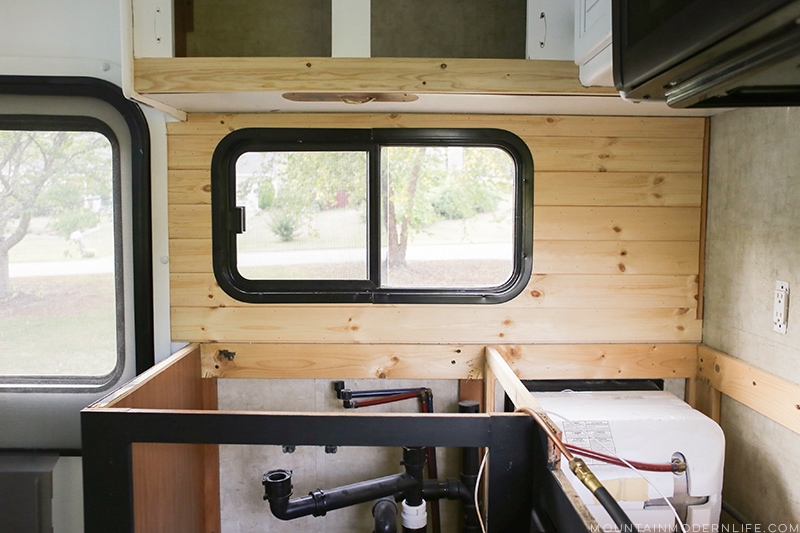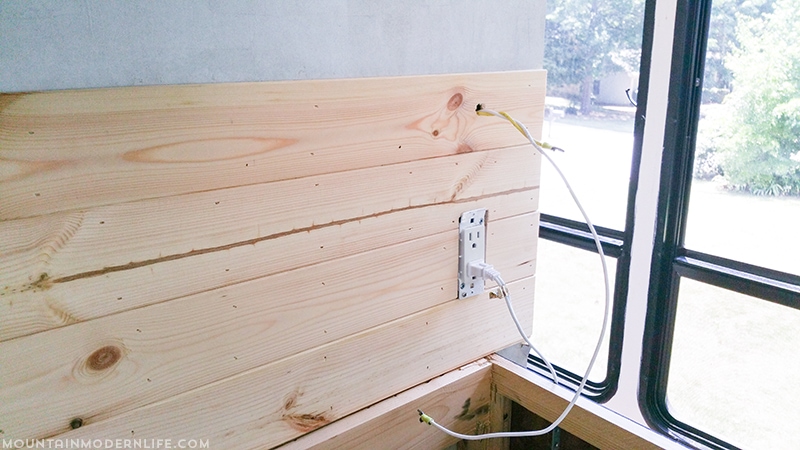UPDATE: All new featured RV tours will be posted on my other website, Wanderful RV Interiors. Existing tours will slowly be moved to the new website, and anything already moved will automatically redirect.
Disclaimer: This post may contain affiliate links, meaning, if you click through and make a purchase we (or those featured in this post) may earn a commission at no additional cost to you. View our full-disclosure here.
Looking to update your kitchen backsplash on a budget? We considered various options when it came time to update the kitchen in our tiny home on wheels, including smart tiles, wallpaper, tin, and copper.
In the end, my heart kept bringing me back to a wood-planked option, which you may already know if you’ve seen our kitchen remodel or holiday tour.
If you’re looking for affordable ways to add rustic charm or farmhouse style to your kitchen, regardless of size, this wood planked backsplash is one way to do just that.
Not only was it fairly simple to install, but it was pretty affordable too. We considered using reclaimed wood, flooring, or even options like Stikwood but ultimately decided to use tongue and groove because it was within budget, lightweight, and easy to install. All in all, it cost us less than $50! The cost may be less or more for you depending on the size of your kitchen, and what supplies you already have on hand. Luckily, we had everything we needed with the exception of the wood and sealer.
Wood Planked Kitchen Backsplash
While I was pretty set on creating a wood planked backsplash from the beginning, I wasn’t sure if I should paint it white or go for a more rustic look. I felt painting it white would help brighten the RV and create a pretty contrast next to the wood counters we would be installing. Then again, the wood could create warmth and bring in more of that cabin-vibe.
Ultimately, we decided to install the planks natural so we could see what they would look like before making a final decision.
The Inspiration
I love the mix of wood and white, it’s rustic, yet modern. Here are a few inspiration photos:
Sources: 1. Hanley Development / 2. Sans for Saint /3. Austin Lineberry – New River Building Co. via HGTV/ 4. Houzz
As a refresh, here’s a before photo of our kitchen when we first purchased our RV:
This list may seem long, but you may already have a lot of these items on hand.
- Tongue and Groove Wood Planks
- Trim/Moulding
- Mallet
- Measuring Tape + Pencil
- Level
- Square
- Stain Blocking Primer
- Paint + Rollers + Waterproof Sealer
- Nail/Wood Filler
- Compound Miter Saw
- Table Saw
- Jigsaw
- Nail Gun
Tip: If you don’t have a lot of power tools or want more of a shiplap appearance you may want to consider using strips of plywood. You can measure what you’ll need ahead of time, and then most hardware stores will cut the plywood down into strips for you. This way you’ll have all of your wood cut to size ahead of time. Or you could use peel and stick planks or flooring.
Here’s a photo of our kitchen during the renovation process. You may recall we painted the uppers, then discovered a nasty water leak and had to remove them. We even had to update some damaged wood, which you can see by the new wood we added to the bottom of the left upper cabinets.
Here are a few more photos before we installed the backsplash. You can see that the outlet covers are already removed.
Ignore the half-painted wall, I was trying to get a sense of how it would look once that area was painted white…
Removing the Window Frame
The first thing we did was remove the frame from the kitchen window.
Measure, Cut, Nail, Repeat
We eventually brought our compound miter saw over to the RV to make it easier to do our cuts, but it got dusty real quick. We wound up setting up a tarp and vacuumed every so often to keep the work area clean.
We then started from the bottom, of the left corner of our kitchen. Installing the first piece of tongue and groove was easy. All we had to do was, measure, cut, line up our tongue and groove using a level, and nail it into place (tongue side down).
You can buy tongue and groove in various sizes and wood types. We used pine because it’s affordable and lightweight, and opted for the longer packs so that we could cut them down to size.
I’ve read that you can use liquid nails to install a wood backsplash, but we decided to nail it in case we ever want to remove it.
Next, we lined up our second board, connected it into the groove, and then used a pencil to outline the shape of the window on the back.
Using our Jigsaw, we cut along our outline and then lightly sanded the board before nailing it into position on the wall.
We weren’t too concerned about the cut being super perfect, because you can’t see the edge when the window frame is installed.
This is what the backsplash looked like with the first two boards in place.
We then continued to measure and mark on the back of our tongue and groove boards so that they lined up to the window.
Here’s a photo showing more progress:
We then had to use our table saw to rip down the top piece so that it would fit.
After the first wall was finished, we moved onto the second wall, starting with the bottom and working our way up.
After the planks were all attached, it was time to install the window frame back in place.
Most of theTrim installed
Here is our pinewood planked kitchen backsplash installed, with nearly all the trim in place. We did end up installing a new corner trim piece because the old trim didn’t go down far enough.
At this point, we were really excited and loved the warmth that the wood brought into the RV. We even installed the outlet covers to get a more “finished feel”.
While it was tempting to leave it as is, I had plans to bring in wood accents in other areas of the RV, including our wood countertop, so we decided painting it white was going to look even better.
Fill, Prime and Paint
I went ahead and filled in all of the nail holes, then sanded the planks down before priming.
Don’t skip priming unless you want to waste extra coats of paint! The last thing you want is to keep layering on paint because the knot holes start to bleed through. Also, if you know for sure you want to paint your planks, you may want to consider priming them before you install, although I don’t think it was any more difficult to paint them afterward.
I also recommend using nail filler vs. wood filler, or some sort of filler that is at least white or light-colored. This is especially the case if you realize you need to fill in more holes after you prime, otherwise, the wood/orange colored filler could bleed through your paint. Not fun. Trust me, I learned this the hard way.
Then after 2 coats of primer, I caulked around any awkward areas. I did this before painting to make sure it would all match. Then it was onto two coats of white paint – the same paint we used on our upper cabinets, walls, and ceiling.
Seal
As for sealing the backsplash, I’ve read that some people will use Polyacrylic or some sort of marine varnish. We used Spar Urethane.
We decided to hold off on adding the corner trim moulding until we had the countertops installed and finished up, which is why you don’t see that finished in the photo below.
Now we have a wood planked kitchen backsplash that adds rustic modern charm to our RV, and in my opinion, looks better than the boring wallpaper border that was previously there.
We created our wood countertops for less than $100, click here to see how we did it!
Here are some additional resources that you may find helpful.
Laminate Flooring Backsplash | Bower Power
Inexpensive Planked Backsplash from Plywood | A Beautiful Mess
Peel and Stick Vinyl Flooring Planked Wall | Remodelaholic
Wood Planked Backsplash | My Fabulous Life



































You did a beautiful job and it brings extra light to your RV.
Thank you Mary, I defintiely agree! I really liked the wood backsplash too, but who knows maybe we’ll save that for our someday sticks and bricks home 🙂
In my experience, Urethane always makes everything a little yellowish. I LOVE Polycrylic. (I also love Deft but I have to really air everything out before my husband gets home and accuses of me of trying to kill him).
But it looks like it didn’t make your white paint yellow at all? This looks much better than the previous wall paper.
I had never use Spar Urethane before but read it was best to use for marine/RV type applications so I wanted to give it a go. It didn’t yellow but I believe that has more to do with the fact I went with a water-based version. I think most people prefer oil-based products, but I can’t stand the smell so we try to use water-based when possible 🙂
Was there any problem installing the window frame as your wall is thicker than just with the wallpaper?
Hey Kristie, there really wasn’t any problem with re-installing the window frame. The screws were still long enough to connect the sides and create a tight bond. Now this could be different in every RV but it worked perfectly fine in our situation. I’d imagine if your screws were not long enough after adding the backsplash you could always get new nails that are a bit longer. The main point is making sure the outside of the window frame and the inside of the window frame go flush with the outer and inner walls. Does that make sense? Anyway let me know if I can clarify a bit better, best wishes, Eric